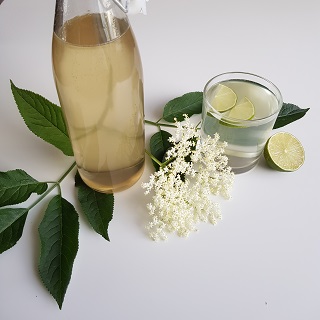Hi,
Elderflower cordial is a family favorite, if not the country’s favorite. It was and is one of the staples in our house. If we don’t have it in the pantry, we are pretty sad. It gives us a refreshing summer drink, and in the winter reminds us of warm days. You can also use it in cocktails and for desserts.
The thing to remember is that the elderflowers you are using have to be of the edible variety. DO NOT use the red elder. The best elder to use is a black elder (Sambucus nigra), which is a European elder.
The citruses you can add, but you can also omit. I used lime this time, but usually, people would use lemon. My mum would make it with no citrus at all – just elderflower. It is still delicious.
When it comes to sugar, I am using refined white sugar this time, but you can also use brown sugar. I would not use the molasses. But I will try to make it with birch sugar in the future. I am trying to avoid the usage of preservatives since I am allergic to them.
Needed things for elderflower cordial
Elderflowers
1 L of water per 10 flowers (round down)
25 g of citric acid per 10 flowers (round down the flower count)
1 kg of sugar per 1 L of liquid
OPTIONAL: 1 lime or 1 lemon per 10 flowers or 1/2 orange
The procedure
The procedure is simple. Forage the elderflowers of European black elder or Sambucus nigra. Then leave them for a couple of hours for bugs to crawl out. (Yeah, I know, the occasional creepy crawly can be present in the flowers and, no, you cannot wash them, pollen is needed in cordial).
Count the flowers and put them into a clean bowl. Depending on your flower count, or wishes add the sliced citrus. You can omit citrus entirely it does not change the number of other ingredients.
Then add the citric acid and water and let them steep for 24 hours. If they are constantly floating to the surface, you may weigh them down with a plate.
After 24 hours, strain the liquid and measure the amount. Then measure the amount of sugar and add it in. I prefer to add 2/3 of sugar and let it completely resolve before adding the last third. When ALL of the sugar has dissolved (it may take up to 48 hrs), bottle the cordial and store it in a dark, cool place.
Video instructions:
Using the elderflower cordial
To make the refreshing beverage, add a small amount to the glass and top with water. You can also use it to sweeten the lemonade or as a syrup for cake. By adding it to the buttercream, you can create an elderflower buttercream. I will make the elderflower cake and put the recipe on soon.
Conclusion
This is my family recipe. We are not using preservatives to store our cordial, therefore we add more sugar, and we use citric acid. The recipe gives the cordial needed stability. Even though citric acid got a bad reputation a couple of years ago, from all that I read recently, it is safe to use. And yes, you can substitute lemon or lime juice for it, but then you would need to add the preservatives, and the steeping time needs to be adjusted. I also am not sure how much lemon juice you may need. I will experiment with it the next year, and let you know the results.
After a couple of days, you may notice syrup becoming murky on top, but that would be just pollen from the elderflowers. You can do a check – if when you shake it gets incorporated into the juice, then it is pollen. It should not develop ANY growth on top. If it bugs you, then you can filter the cordial to get rid of the entire pollen. But usually, we don’t. In time the pollen sets in the bottom of the bottle. You won’t get sick from drinking it 🙂
If you are a bit worried, you can also cook the cordial for a couple of minutes on the stove before bottling, but we don’t do that. I hope to give this a try. It is a European pantry staple.



